Car parking’s influence on cycling
From the 1950s onwards, an increasing number of Dutch people own cars. Travel by car, coined as the ‘means of transport of the future’ gave freedom to drivers. But the narrow streets of Amsterdam soon became overcrowded by cars. Several attempts to improve this were fruitless. Cars continued to occupy a large part of the city space especially in the form of parking. Only since paid parking was turned into a local tax the city can actually manage car parking. Find out how fiscal parking improved the mobility of the city. And how the car parking policy helped Amsterdam turn into a bike city again.
Before
As a result of the massive motorisation since the 1950s, Amsterdam became increasingly crowded with cars. In addition to cars of Amsterdammers, everyday thousands of commuters and visitors travelled to the city by car. Parked cars filled up the streets, sidewalks and bike lanes. Even the most beautiful squares and canals in the city were turned into parking lots.
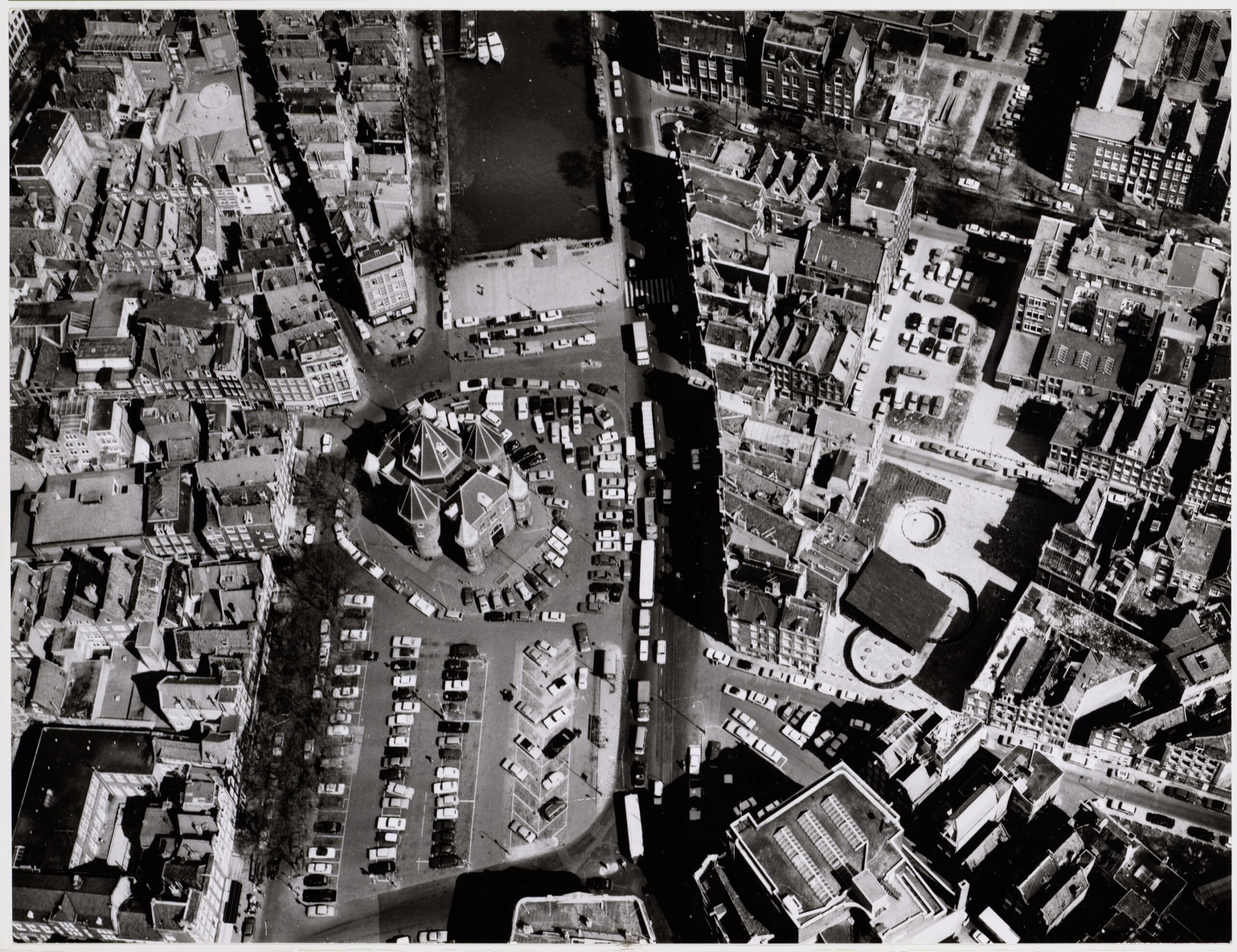
Nieuwmarkt fully parked with cars, 1970. Photo: Stadsarchief Amsterdam/ dep. Public Works
Parked cars were taking up space and hindering pedestrians and cyclists severely. Sometimes even the fire brigade and ambulance were blocked by parked cars. To deal with these problems, police commissioner Kaasjager outlined what was needed to provide sufficient space for all the cars. The commissioner’s solutions included filling in canals (highlighted red in the picture below) and demolishing houses (highlighted black). This provocative proposal sparked a storm of protests. Perhaps, that was exactly what Kaasjager intended.
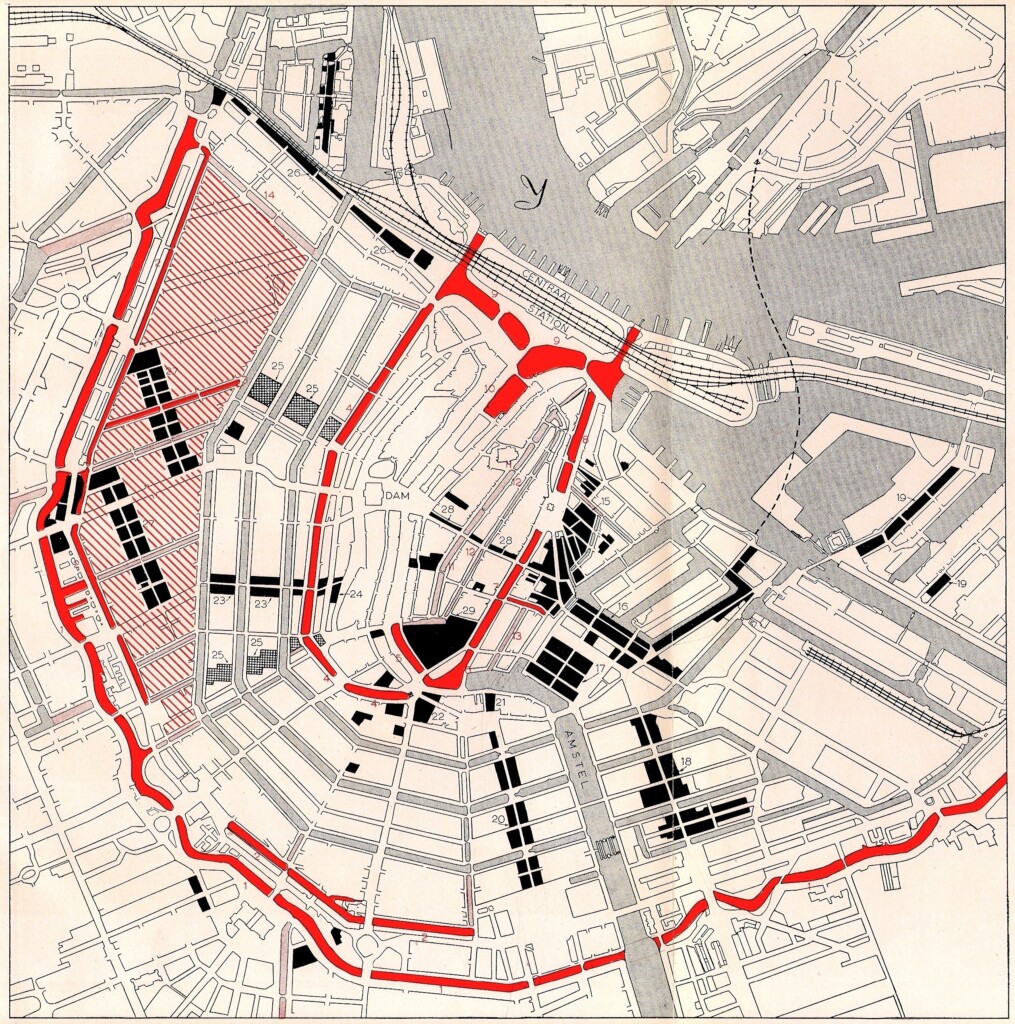
Plan Kaasjager, 1956. Source: Alarm in Amsterdam, 1956, Geurt Brinkgreve.
Parking enforcement was the only way to keep the city safe and accessible. But enforcement was costly and the police were limited in time. The chances of being fined for incorrect parking were minimal. And as a result, thousands of parking violations were committed on a daily basis. In 1987 Amsterdam’s Traffic Council wrote an extensive report (in Dutch) on illegal parking and possible measures.
Indignant residents stood up in action against the nuisance and unsafety caused by illegal parking. Using action stickers, research and playful actions in the media. For example, in 1987 an alternative ‘Parking Management Service’ was set up. An activistic response to the planned municipal service that was delayed and delayed in coming to fruition.
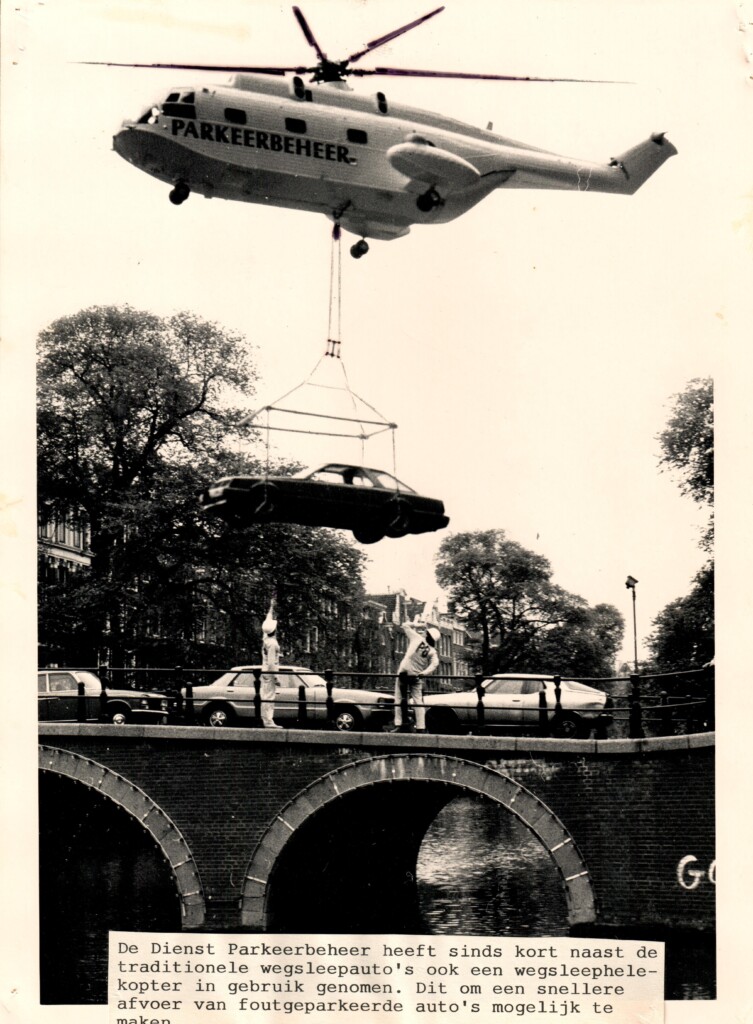
Actiegroep (alternatief) Dienst Parkeerbeheer vertegenwoordigt een takelhelikopter in de strijd tegen parkeerovertredingen. Fotomontage gebruikt in persbericht. Foto: Alternatieve Dienst Parkeerbeheer Amsterdam, omstreeks 1987, Archief Fietsersbond Amsterdam
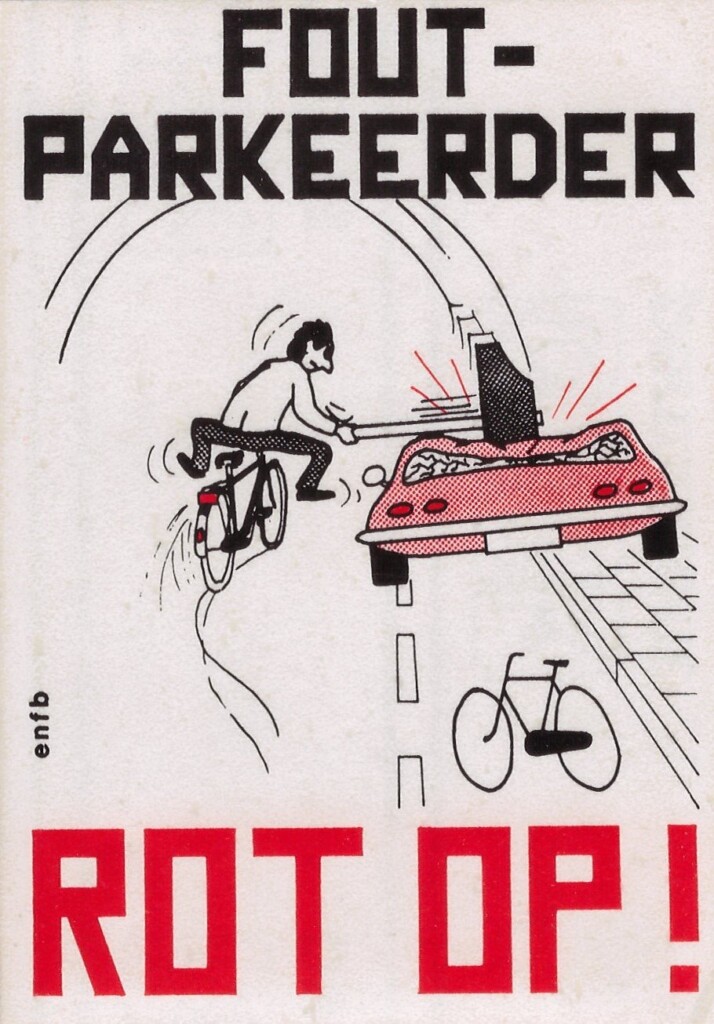
Sticker tegen illegaal parkeren. Beeld: enfb, archief Fietsersbond Amsterdam
Handhaving door ontwerp
Soms kan foutparkeren worden tegengegaan door slim te ontwerpen. Automobilisten trekken zich bij foutparkeren weinig van anderen aan, behalve als ze daarmee de doorgang van andere auto’s blokkeren. Een rijbaan van max. 3,85m breed houdt zichzelf zo vrij van foutparkeren, terwijl hij net breed genoeg is voor auto’s in één richting en tweerichting fiets. In Amsterdam zijn vele straten en bruggen volgens deze inzichten ingericht. Het rapport Veiliger Fietsen in Amsterdam van ambtenaar Hans Metz uit 1987 gaat hier verder op in.
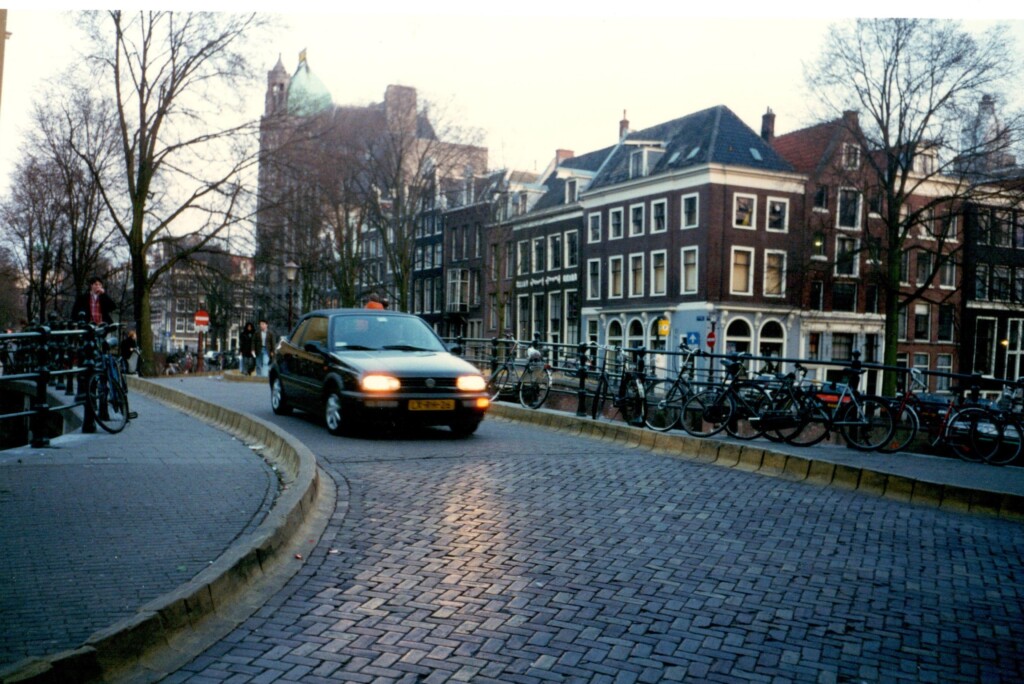
Een smalle weg met hoge randen voorkomt illegaal parkeren op bruggen. Foto: Archief Fietsersbond Amsterdam
Om stoepen vrij van foutparkeerders te houden werden duizenden paaltjes geplaatst. Ze kregen de geuzennaam Amsterdammertjes.
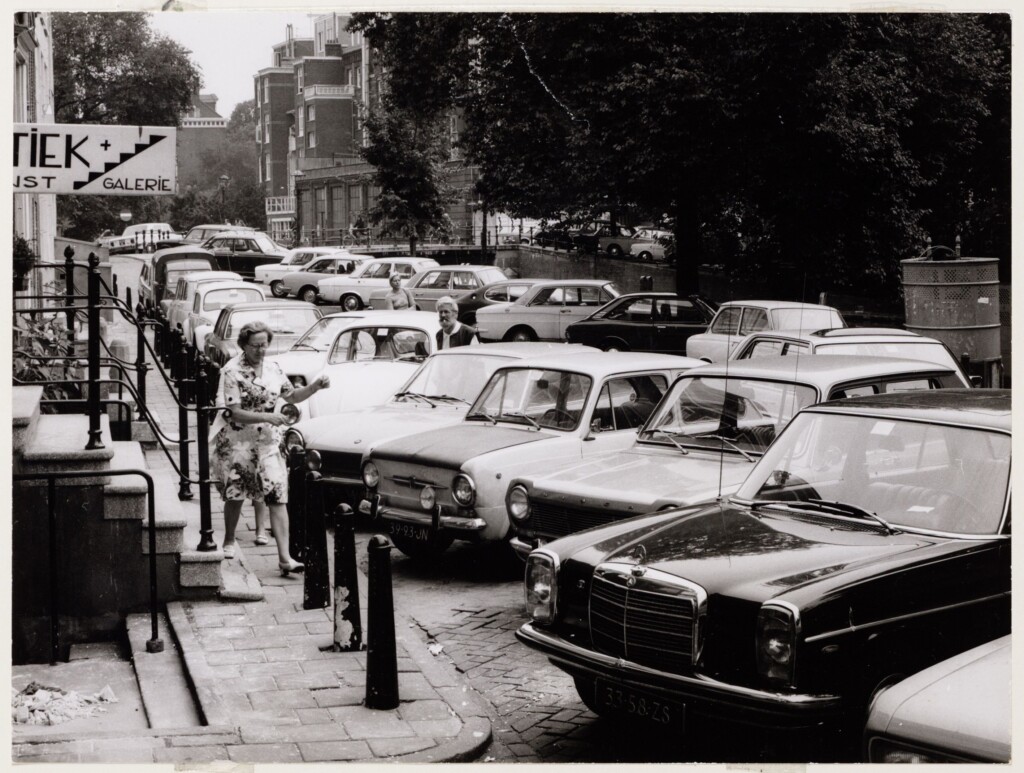
Alleen een rij palen laat wat loopruimte achter. Lijnbaansgracht, 1981. Foto: Stadsarchief Amsterdam/ Roël, Ino
Straathoeken vrij maken van geparkeerde auto’s is een eenvoudig maar belangrijk middel om de veiligheid van fietsers en voet gangers te verbeteren. Het zorgt voor ruimte en beter zicht op de kruising. Vanaf eind jaren 1970 werden talloze kruispunten op deze manier verbeterd.
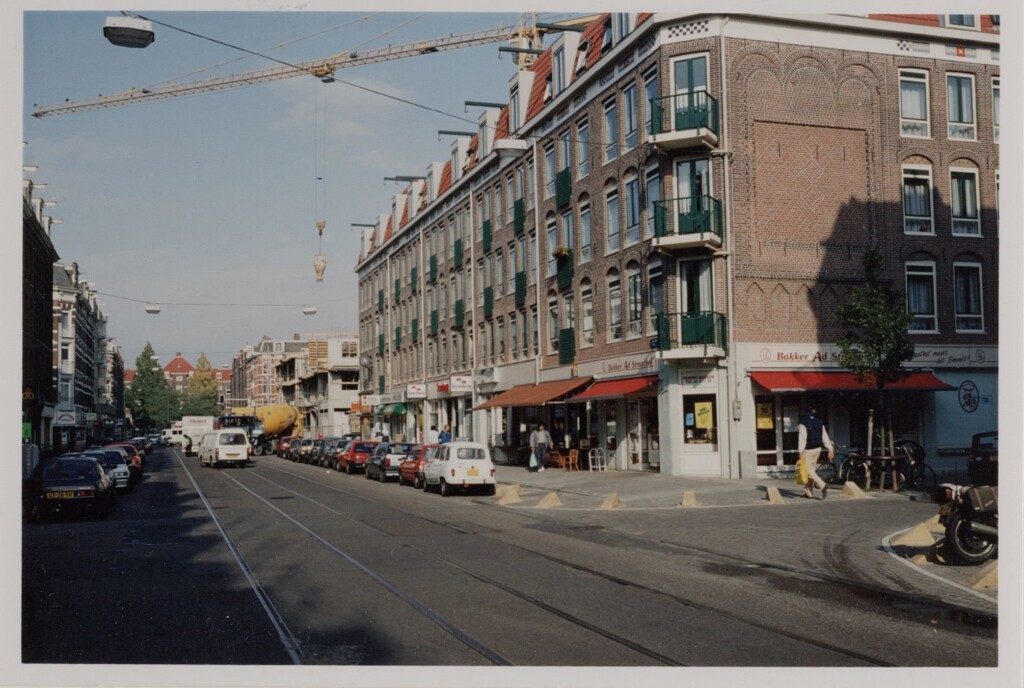
Straathoek parkeervrij dankzij betonnen driehoeken, 1991. Foto: Stadsarchief Amsterdam
Gegevens
In 2019 bedroegen de inkomsten uit betaald parkeren in Amsterdam ongeveer € 200 miljoen. Deze opbrengst wordt besteed aan de volgende doelen:
- Meer ruimte voor wonen, spelen en groen op straat;
- Duurzame bereikbaarheid van Amsterdam;
- Verbetering van de luchtkwaliteit en klimaatadaptatie;
- Verbetering van de verkeersveiligheid; En
- Specifieke lokale doelen uit gebiedsplannen/agenda’s.
Volgens de laatste cijfers zijn er ongeveer 266.000 parkeerplaatsen op straat in Amsterdam, waarvan bij 150.000 betaald parkeren geld betaald parkeren. Bovendien zijn er ongeveer 167.000 parkeerplaatsen in parkeergarages, waarvan 34.000 in openbare garages. Van de 167.000 plekken in garages zijn ongeveer 33.000 gekoppeld aan woningen.
Parkeerplaatsen in de straat nemen ongeveer 10% van de openbare ruimte in Amsterdam in beslag. In de dichter bebouwde kom kunnen parkeerplaatsen tot 20% van de openbare ruimte in beslag nemen. Gegevens van: Amsterdamse Thermometer van de Bereikbaarheid 2019.
Het Engelstalige rapport van het Amsterdam Mobility Fund gaat in op betaald parkeren en het mobiliteitsfonds van Amsterdam.
Onze vragen
Wat vindt u van het parkeerbeleid van Amsterdam? Welke maatregelen neemt uw stad om het parkeren te regelen? Zijn daar kansen om alternatieven voor de auto te verbeteren. Deel het hieronder via Disqus!
Effective parking policy
In 1991 paid parking became a local tax: fiscal parking. Municipal officials were given the authority to enforce parking regulations. Finally, municipalities could implement effective parking policies.
Effective enforcement ensures that the majority of parking motorists pay the parking fees. As a result, also fewer cars were parked, and fewer parking spaces were needed. The freed-up space plus the revenues of paid parking were essential for many mobility improvements in Amsterdam. Improvements for cyclists, pedestrians, public transportation and public space.
Paid parking faced opposition as well. Particularly from businesses and residents who were afraid of losing customers and visitors traveling by car. But Amsterdam uses its parking policy to improve alternatives to the car.
Today
Parking is expensive in Amsterdam, especially for visitors. Now (2020) city centre visitors pay up to €7.50 per hour. This discourages long-term parking by visitors and creates more available parking spaces for short-term visitors and residents. By now, paid parking is implemented in a large part of the city.
Residents and businesses can obtain a parking permit which is way cheaper. The permit is only valid in one’s own neighbourhood and costs up to approximately €50 per month, depending on the neighbourhood. In each neighbourhood, a limited number of permits can be issued. Notably, about 80% of parked cars belong to permit holders.
Over the years, numerous facilities for pedestrians, cyclists and public transportation have been realised through the income and space generated by the parking policy. In some cases, parking garages are also financed by the parking income. This allows permit holders to park underground which frees up street level space in crowded areas.
A good example are the 600 parking places in the new Albert Cuyp garage situated under the water of Boerenwetering. When the garage opened, a total of 600 on-street parking spaces were removed in the local area. This served as a great improvement to the crowded and narrow streets of Frans Halsbuurt.
Improved enforcement
Enforcement of paid parking was initially done manually by inspectors on the street. Since 2013, Amsterdam has been working with scan-cars that automatically scan the number plates of parked cars and check if the respective payment has been made. This ensures better enforcement and improved payment discipline. Since 2017, the scan cars also check for incorrect parking on the sidewalk and outside the parking spaces.
Tomorrow
Parking continues to develop. In the context of the Agenda Amsterdam Autoluw program, more than 10,000 parking spaces on the street will be taken out in the period between 2018 and 2022.
Until recently, new housing developments were constructed based on one parking space per home. But now new large new-build locations integrate much lower parking standards. In Sluisbuurt, a ratio of 0.3 parking spaces per home is employed while that of 0.2 is applicable in Haven-Stad. More information about the car and parking policy of Amsterdam can be found in the Memorandum on Parking Cars, 2017.
Outside Amsterdam
In the region, there is more space available than in the city of Amsterdam. Parked cars are therefore less perceived as a problem. In most surrounding municipalities, there is only paid parking in busy areas such as the centre. New construction in the region is based on more parking spaces per home than in Amsterdam.
Data
In 2019, the income from paid parking in Amsterdam was approximately €200 million. This revenue is spent on the following goals:
- More space for living, playing and greenery in the street;
- Sustainable accessibility of Amsterdam;
- Improving air quality and climate adaptation;
- Improving road safety;
- and Specific local goals from area plans/agendas.
According to the latest figures, there are approximately 266,000 street parking spaces in Amsterdam of which 150,000 are located in the fiscal parking area. On top of this, there are about 167,000 parking spaces in parking garages of which 34,000 are in public garages. Furthermore, about 33,000 of the 167,000 garage spaces are linked to homes.
Parking spaces in the street take up about 10% of the public space in Amsterdam. In the more densely build-up areas, car parking areas can take up to 20% of public space.
The English report Amsterdam Mobility Fund takes a closer look at paid parking and the mobility fund of Amsterdam.
Our questions
What do you think of the parking policy of Amsterdam? What kind of measures or solutions does your city have to regulate parking of cars? Are there changes to improve alternatives for the car? Share it via Disqus below!










